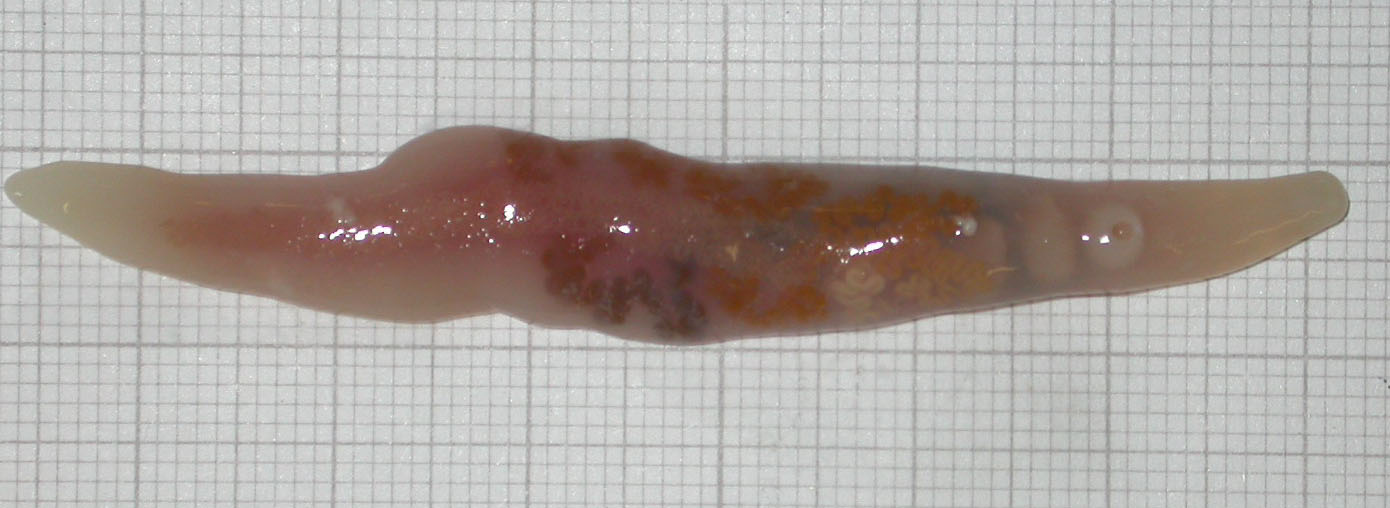- Trematoda
Taxobox
name = Trematoda

image_width = 250px
image_caption = "Botulus microporus", a giant digenean parasite from the intestine of alancetfish
regnum =Animal ia
subregnum =Eumetazoa
unranked_phylum =Bilateria
superphylum =Platyzoa
phylum =Platyhelminthes
classis = Trematoda
classis_authority = Rudolphi, 1808
subdivision_ranks = Subclasses
subdivision =Aspidogastrea Digenea The Trematoda is a class within the phylum
Platyhelminthes that contains two groups of parasiticworm s, commonly referred to as flukes.Taxonomy and biodiversity
The Trematoda are estimated to include 18 000cite book |last=Littlewood |first=D T J |coauthors=R. A. Bray |title=Interrelationships of the Platyhelminthes |series=Systematics Association Special Volume |volume=60 |edition=1 |date=
2000-12-07 |publisher=CRC |isbn=978-0748409037|pages=168–185 |chapter=The Digenea] to 24 000cite book |last=Poulin |first=Robert |coauthors=Serge Morand |title=Parasite Biodiversity |date=2005-01-07 |publisher=Smithsonian |isbn=978-1588341709 |pages=216] species, and are divided into two subclasses. Nearly all trematodes are parasites of molluscs and vertebrates. The smallerAspidogastrea , comprising about 100 species, areobligate parasite s of molluscs and may also infect turtles and fish, including cartilaginous fish. TheDigenea , which constitute the majority of trematode diversity, are obligate parasites of both molluscs and vertebrates, but rarely occur in cartilaginous fish.Formerly the
Monogenea were included in the Trematoda on the basis that these worms are alsovermiform parasites, but modern phylogenetic studies have raised this group to the status of a sister class within the Platyhelminthes, along with theCestoda .Life cycles
Almost all trematodes infect molluscs as the first host in the life cycle, and most have a complex life cycle involving other hosts. Most trematodes are monoecious and alternately reproduce sexually and asexually. The two main exceptions to this are the Aspidogastrea, which have no asexual reproduction, and the schistosomes, which are dioecious.
In the definitive host, in which sexual reproduction occurs, eggs are commonly shed along with host
feces . Eggs shed in water release free-swimming larval forms that are infective to the intermediate host, in which asexual reproduction occurs.Infections
Human infections are most common in the Orient, Africa, South America, or the Middle East. However, trematodes can be found anywhere that human waste is used as fertilizer. Trematodes normally inhabit the digestive system and/or liver. Some trematodes seek out the lungs, or may wander to the heart, brain or skin. In the digestive system or liver, they disrupt digestion and nutrient absorption. Symptoms include chronic diarrhea and abdominal pain. Other symptoms occur from long-standing infections. These symptoms include
ulcers , hemorrage and abscessess of the intestinal wall, and liver damage. Sometimes severe toxemia results when the host's body absorbs the worm's metabolites. The most common medications used to kill trematodes arepraziquantel ,niclosamide , or tetrachloroethylene. However, currently, only limited information about treating these infections is available.Trematode infections are usually acquired after ingesting one of the infective forms. Most fluke infections are acquired by (1) drinking infected water, (2) swallowing infected water while swimming; transmission from wet hands to mouth or nose, etc., (3) eating infected aquatic vegetation, or (4) eating infected raw meat or raw intermediate hosts (snails, shellfish, crustaceans, fish). One can kill trematodes by thoroughly cooking meats and vegetable taken from suspect waters. Salting, pickling, drying, and smoking does not always kill the parasites in meat. [cite web |url=http://www.cartage.org.lb/en/themes/Sciences/LifeScience/GeneralBiology/Microbiology/ParasiticFlukes/ParasiticFlukes.htm |title=Parasitic Flukes and Worms |accessdate=2008-06-28]
Etymology
Trematodes are commonly referred to as "flukes". This term can be traced back to the
Old English name forflounder , and refers to the flattened, rhomboidal shape of the worms.The flukes can be classified into two groups, on the basis of the system which they infect in the vertebrate host. Tissue flukes infect the
bile duct s,lung s, or otherbiological tissue s. This group includes the lung fluke, "Paragonimus westermani ", and theliver fluke s, "Clonorchis sinensis" and "Fasciola hepatica ". Blood flukes inhabit theblood in some stages of their life cycle. Blood flukes include species of the genus "Schistosoma ".They may also be classified according to the environment in which they are found. For instance, pond flukes infect fish in ponds. [Examples of the use of this term:
*cite web |url=http://www.petmountain.com/product/medications/503576/aquarium-products-pond-fluke-tabs-20ct.html |title=Pond Fluke Tabs-20ct |accessdate=2008-06-28 |publisher=Pet Mountain
*cite web |url=http://www.thatpetplace.com/pet/prod/208984/product.web |title=AP Pond Fluke - 20 pk |accessdate=2008-06-28 |publisher=That Fish Place - That Pet Place]References
Wikimedia Foundation. 2010.
